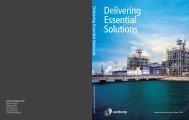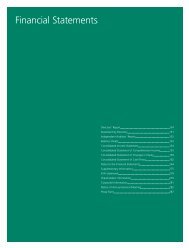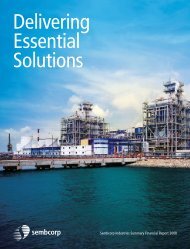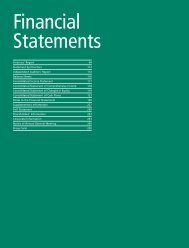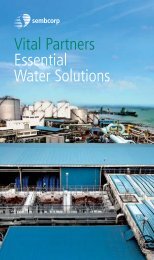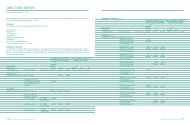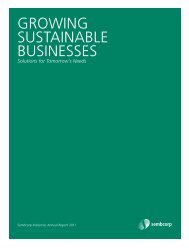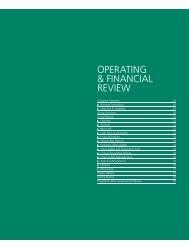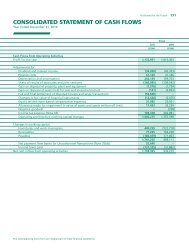FINANCIAL STATEMENTS (Full Version) - Sembcorp
FINANCIAL STATEMENTS (Full Version) - Sembcorp
FINANCIAL STATEMENTS (Full Version) - Sembcorp
Create successful ePaper yourself
Turn your PDF publications into a flip-book with our unique Google optimized e-Paper software.
Notes to the<br />
Financial Statements<br />
Year Ended December 31, 2008<br />
2. SUMMARY OF SIGNIFICANT ACCOUNTING POLICIES (cont’d)<br />
b. Consolidation (cont’d)<br />
iii. Joint Ventures (cont’d)<br />
The excess of the Group’s interest in the net fair value of the identifiable assets, liabilities and contingent<br />
liabilities over the cost of acquisition is credited to the income statement in the period of the acquisition.<br />
Where the audited financial statements are not available, the share of results is arrived at from unaudited<br />
management financial statements made up mainly to the end of the accounting year to December 31.<br />
iv. Associates and Joint Ventures in the Company’s Financial Statements<br />
Investments in associates and joint ventures are stated in the Company’s balance sheet at cost less impairment<br />
losses.<br />
The results of the associates and joint ventures are included in the Company’s income statement to the extent<br />
of dividends received and receivable, provided the Company’s right to receive the dividend is established<br />
before the balance sheet date.<br />
v. Transactions Eliminated on Consolidation<br />
All significant intra-group transactions, balances and unrealised gains or losses are eliminated on consolidation.<br />
Unrealised gains resulting from transactions with associates and joint ventures are eliminated to the extent of<br />
the Group’s interest in the enterprise. Unrealised losses are eliminated in the same way as unrealised gains, but<br />
only to the extent that there is no evidence of impairment.<br />
vi. Accounting Policies of Subsidiaries, Associates and Joint Ventures<br />
Where necessary, accounting policies for subsidiaries and material associates and joint ventures have been<br />
adjusted on consolidation to be consistent with the policies adopted by the Group.<br />
c. Foreign Currencies<br />
i. Functional and Presentation Currency<br />
Items included in the financial statements of each company in the Group are measured using the currency<br />
of the primary economic environment in which the company operates (“the functional currency”). The<br />
consolidated financial statements are presented in Singapore dollars, which is the Company’s functional and<br />
presentation currency.<br />
2. SUMMARY OF SIGNIFICANT ACCOUNTING POLICIES (cont’d)<br />
c. Foreign Currencies (cont’d)<br />
iii. Foreign Operations<br />
The results and financial positions of foreign operations (none of which have the currency of a hyperinflationary<br />
economy) that have a functional currency different from the presentation currency are translated into the<br />
presentation currency as follows:<br />
• Assets and liabilities are translated at foreign exchange rates ruling at the date of the balance sheet.<br />
• Revenues and expenses are translated at average foreign exchange rates.<br />
• All resulting foreign exchange differences are taken to the currency translation reserve.<br />
Goodwill (except those relating to acquisitions of foreign operations prior to January 1, 2004) and fair value<br />
adjustments arising from the acquisition of foreign operations are translated to the presentation currency for<br />
consolidation at the rates of exchange ruling at the balance sheet date. Goodwill arising from the acquisition<br />
of foreign operations prior to January 1, 2004 are translated at foreign exchange rates ruling at the dates of<br />
the transactions.<br />
On disposal, accumulated currency translation differences are recognised in the consolidated income statement<br />
as part of the gain or loss on disposal.<br />
iv. Net Investment in a Foreign Operation<br />
Exchange differences arising from monetary items that in substance form part of the Company’s net investment<br />
in a foreign operation are recognised in the Company’s income statement. Such exchange differences are<br />
reclassified to the currency translation reserve in the consolidated financial statements and are released to the<br />
consolidated income statement upon disposal of the investment as part of the gain or loss on disposal.<br />
d. Property, Plant and Equipment<br />
i. Owned Assets<br />
Property, plant and equipment are stated at cost less accumulated depreciation and accumulated impairment<br />
losses. Cost includes expenditure that is directly attributable to the acquisition of the asset.<br />
The cost of self-constructed assets includes the cost of materials, direct labour and an appropriate proportion<br />
of production overheads.<br />
ii.<br />
Foreign Currency Transactions and Balances<br />
Transactions in foreign currencies are translated into the functional currency at foreign exchange rates ruling<br />
at the dates of the transactions. At each balance sheet date:<br />
• Foreign currency monetary items are translated into the functional currency using foreign exchange rates<br />
ruling at that date.<br />
• Non-monetary assets and liabilities measured at historical cost in foreign currencies are translated into the<br />
functional currency using foreign exchange rates at the dates of the transactions.<br />
• Non-monetary assets and liabilities measured at fair value in foreign currencies are translated into the<br />
functional currency at foreign exchange rates ruling at the dates the fair value was determined.<br />
Foreign exchange differences arising from the settlement or from translation of monetary items are recognised<br />
in the income statement.<br />
Foreign exchange differences arising from non-monetary items are recognised directly in equity when nonmonetary<br />
items’ gains or losses are recognised directly in equity. Conversely, when non-monetary items’ gains<br />
or losses are recognised directly in the income statement, foreign exchange differences arising from these<br />
items are recognised directly in the income statement.<br />
ii.<br />
Where an item of property, plant and equipment comprises major components having different useful lives,<br />
they are accounted for as separate items of property, plant and equipment.<br />
Revaluation Surplus<br />
Any increase in revaluation is credited to the revaluation reserve unless it offsets a previous decrease in value<br />
recognised in the income statement. A decrease in value is recognised in the income statement where it<br />
exceeds the increase previously recognised in the revaluation surplus of the same asset.<br />
iii. Subsequent Expenditure<br />
Subsequent expenditure relating to property, plant and equipment that has already been recognised is<br />
added to the carrying amount of the asset when it is probable that future economic benefits, in excess of the<br />
originally assessed standard of performance of the existing asset, will flow to the Group. All other subsequent<br />
expenditure is recognised as an expense in the period in which it is incurred.<br />
Certain items of property, plant and equipment are subject to overhauls at regular intervals. The inherent<br />
components of the initial overhaul are determined based on the estimated costs of the next overhaul and<br />
are separately depreciated in order to reflect the estimated intervals between two overhauls. The costs of<br />
the overhauls subsequently incurred are capitalised as additions and the carrying amounts of the replaced<br />
components are written off to the income statement.<br />
122 Delivering Essential Solutions <strong>Sembcorp</strong> Industries Annual Report 2008 123



